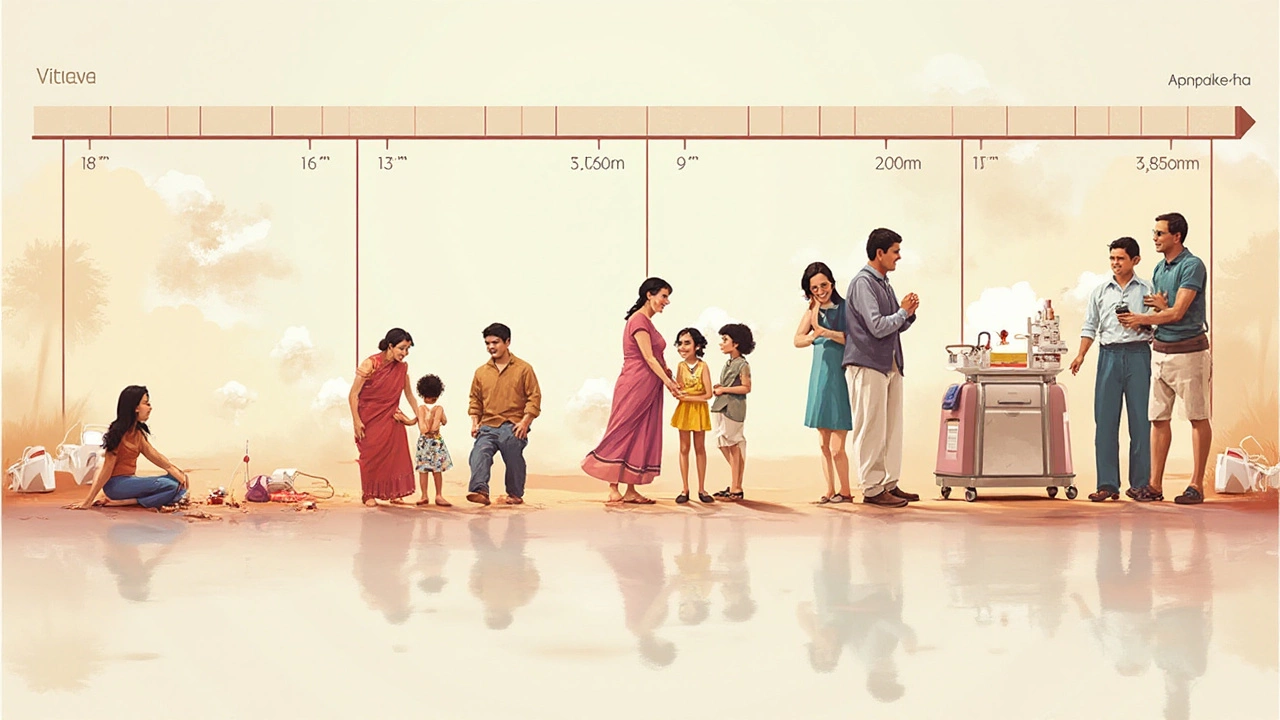In July 1978, a medical breakthrough captured the world's attention and forever altered the landscape of reproductive medicine. The birth of Louise Brown, the first individual born via in vitro fertilization (IVF), marked a new chapter in human history. Her arrival not only brought hope to countless couples struggling with infertility but also sparked debates and discussions that continue to this day.
The implications of Louise's birth went far beyond her family's joy, as it represented a leap in scientific achievement. Today, we take a closer look at her story, the massive strides IVF has made since then, and how her beginning set a precedent for innovation in fertility treatments across the globe. Join us as we delve into the legacy of the most famous IVF baby and the ongoing progress in this transformative field.
- The Birth of Louise Brown
- Impact on Fertility Treatments
- Advancements in IVF Technology
- Societal Changes and Acceptance
- Key Milestones in IVF History
- Future of IVF and Reproductive Medicine
The Birth of Louise Brown
On a balmy day in July 1978, a miracle unfolded in Oldham General Hospital, England, that would transform the world's understanding of reproductive technology. Louise Joy Brown entered the world as the first human to be born through in vitro fertilization, a testament to the tireless dedication of medical pioneers and the hope of countless families longing for children. Her conception in a Petri dish, facilitated by Dr. Robert Edwards and Dr. Patrick Steptoe, involved the meticulous extraction and fertilization of an egg outside the womb—a process then deemed almost fantastical.
This groundbreaking birth was not without its challenges. At that point, the ethical and medical landscapes were complex, marked by skepticism and fierce debate. Religious leaders, scientists, and policymakers voiced their concerns, each pondering the implications of such unprecedented scientific advancement. Yet amidst the controversy, the joy of Leslie and John Brown, Louise's parents, was unmatched, as they cradled their long-awaited miracle in their arms. The sheer brilliance of Dr. Edwards, who was later awarded the Nobel Prize for Physiology or Medicine in 2010, had brought forth a new era, one that would soon brim with potential for those struggling with infertility.
Louise's birth was more than an exceptional medical achievement; it symbolized a colossal leap in understanding human potential and the capabilities of science. As Britain and the rest of the world watched in awe, the Browns stood as a beacon of hope and possibility. "The triumph was not just scientific—it was deeply human," Dr. Edwards once remarked, encapsulating the emotional and personal victory that accompanied this global breakthrough. His pioneering work, alongside Steptoe's, laid the foundational stone for what would become a thriving field that has since brought smiles to millions of faces.
Fast-forward to the present day, where IVF is responsible for over eight million births worldwide, according to the International Committee Monitoring Assisted Reproductive Technologies. The evolving landscape of this medical marvel owes its very genesis to Louise Brown's arrival. Her birth not only opened new doors for family creation but also spurred ongoing research and innovation in reproductive medicine. Studies suggest that the introduction of IVF has significantly altered perceptions of infertility, reducing stigma and enhancing awareness.
Impact on Fertility Treatments
The arrival of Louise Brown signaled a seismic shift in how the world viewed infertility and its treatment. Before the birth of this pioneering IVF baby, many couples faced despair as conventional methods of overcoming infertility often provided limited solutions. The success of in vitro fertilization not only expanded the possibilities for prospective parents but also ignited a wave of innovation in fertility medicine across the globe. People began to understand that something once deemed impossible could indeed be achieved, leading to a surge of interest and investment in reproductive technologies.
One of the most significant impacts was the increase in research funding for fertility-related studies. As researchers sought to refine and improve IVF techniques, they explored new methods and technologies. This included advances in hormone therapies, improved egg retrieval techniques, and more effective embryo implantation processes. The progress in these areas has since contributed to higher success rates and has reduced the emotional and financial strain on couples seeking treatment. With each breakthrough, the hope for building a family became more attainable, bringing comfort to those previously told it was unlikely.
The societal impact of IVF was equally transformative. The success of Louise's birth prompted discussions on fertility rights and reproductive health, pushing boundaries that had previously been considered taboo. It called attention to the struggles faced by individuals experiencing infertility, encouraging broader acceptance and understanding. This cultural shift was bolstered by increasing media coverage and public interest, helping to normalize conversations around reproductive health. The narrative moved from a sense of shame to one of empowerment as more people felt emboldened to seek help and explore their options.
Dr. Robert Edwards, one of the scientists behind the groundbreaking IVF procedure, famously remarked,
"It is a delight to have been able to assist so many couples in realizing their dream of parenthood. This was only the beginning of what we believe will be a long line of innovations in fertility treatments."His words resonated through medical communities and beyond, inspiring new generations of scientists and doctors to dedicate themselves to advancing reproductive technologies. The collaboration between practitioners worldwide has led to improvements not only in IVF but in associated areas like genetics and maternal healthcare.
Today, approximately eight million babies have been born as a result of IVF and other assisted reproductive technologies since Louise first opened her eyes. This vast number is a testament to how the field has diversified and improved, becoming more inclusive and accessible to a wider range of individuals. Fertility treatments have expanded to include techniques like ICSI, egg freezing, and preimplantation genetic diagnosis, offering tailored solutions to meet varied needs. The journey from the first IVF baby to the millions born today showcases a remarkable evolution in reproductive health.
In the years following Louise Brown's birth, IVF has become a cornerstone of modern reproductive medicine. The hope it provides for countless families, coupled with the ongoing dedication of researchers and medical professionals, highlights the profound and lasting impact that one tiny baby had on the world. Louise's legacy lives on as a symbol of possibility, resilience, and the relentless pursuit of knowledge in the face of adversity. As we look to the future, her story continues to inspire and drive innovations in fertility treatments, ensuring that everyone who dreams of parenthood has a fighting chance to make that dream come true.

Advancements in IVF Technology
The journey of in vitro fertilization from its inception to its current status as a commonly practiced medical procedure is marked with remarkable scientific and technological advancements. Early IVF treatments were groundbreaking yet rudimentary, often met with skepticism and high failure rates. However, decades of research and innovation have transformed these early methods into highly sophisticated protocols yielding success rates that were once unimaginable. Early on, scientists recognized the need to improve embryo culture conditions. This need led to the development of better culture media, which are designed to mimic the natural environment of the female reproductive tract. Such enhancements have significantly improved embryo viability and IVF success rates over the years.
A pivotal moment in IVF technology was the introduction of intracytoplasmic sperm injection (ICSI). This technique revolutionized treatments for male infertility by allowing a single sperm to be directly injected into an egg, thereby assisting fertilization in cases where traditional IVF might fail. The success of ICSI underscores the adaptability and continual refinement of IVF procedures to better meet the needs of diverse patients. Genetic screening technologies, such as preimplantation genetic testing (PGT), have also revolutionized IVF outcomes. These screenings enable the selection of embryos free from genetic disorders, significantly increasing the chances of successful pregnancies and healthy births.
With the advent of cryopreservation techniques, embryos, eggs, and even ovarian tissues can now be frozen and thawed with minimal impact on their viability. This advancement not only aids in fertility preservation but also offers a greater degree of flexibility in the timing of embryo transfers, enhancing success rates and providing better options for patients facing challenging life situations. As technology continues to advance, so too do the ethical discussions and legislative considerations surrounding these powerful capabilities. Many countries are now developing comprehensive frameworks to ensure the responsible use of emerging IVF technologies. The future of IVF is promising and expansive, with ongoing research into the integration of artificial intelligence and machine learning. Such technologies aim to further personalize treatments and predict pregnancy outcomes with greater accuracy. As scientists push the boundaries of what is possible, they draw inspiration from the stories of pioneering individuals, like Louise Brown, who have been at the heart of IVF advancements.
According to Dr. Robert Winston, a prominent figure in the field, "IVF is not just a technological advance, it's a social revolution. It has changed our attitude to conception and family formation in remarkable ways."
Societal Changes and Acceptance
When Louise Brown was born in 1978 as the first successful result of in vitro fertilization, the news created ripples across the globe. It wasn’t just a medical milestone; it posed significant moral and ethical questions. The thought of conceiving life outside a woman's body led to heated debates in both philosophical and religious circles. Concerns about 'playing God' and fears about potential unknown consequences fueled much of the early controversy, setting a stage where acceptance would come gradually rather than overnight.
Initially, the idea of IVF was met with skepticism and, occasionally, hostility. In time, as the method proved to be not only viable but successful in bringing joy to families struggling with infertility, perceptions started to shift. By the late 1980s and into the 1990s, more stories emerged of couples who had successfully had children through IVF, helping to normalize the procedure. Media representations began to portray IVF families positively, further aiding the slow yet steady march towards acceptance. Today, IVF is a widely accepted part of modern medicine, reflecting how far public opinion has evolved.
In the Western world, acceptance came quicker, aided by advancements in fertility research and increased public awareness. The need for assisted reproductive technologies became increasingly recognized, especially by those facing infertility due to age or medical conditions. Accessibility played a vital role too. As more clinics offered treatments and as techniques improved, IVF became an option for a broader demographic, stripping away the notion that it was for a niche group. Interestingly, empirical data suggest that nearly 8 million babies have been born through IVF since Louise's birth, a testament to the procedure's normalization and ubiquity.
However, societal acceptance is not uniform worldwide. In some cultures and regions, religious beliefs and traditional values still influence opinions about IVF. In countries where familial lineage and natural childbirth are deeply revered customs, widespread acceptance of IVF lags. Although technological strides continue, societal progress in these regions is gradual. The economic factor also plays into access and acceptance, as many cannot afford treatments without substantial financial aid. Yet, as dialogues around reproductive rights gain momentum, there's hope for broader acceptance and accessibility.
From a sociological viewpoint, the way IVF reshaped discussions about family is significant. It expanded the definition of what constitutes family beyond biological connections, acknowledging the myriad ways people can become parents. As IVF became more common, other assisted reproductive technologies like surrogacy and adoption gained visibility, prompting societies to examine and often expand their own definitions of family. In ways, Louise Brown’s birth was a catalyst for such progressive views, highlighting how an individual's entry into the world could spark a wider embrace of diverse family structures.
"IVF has moved from the realms of the extraordinary to the routine," said Professor Robert Edwards, one of the pioneers of IVF, during an interview reflecting on the procedure’s evolution. His statement underscores the journey of IVF from skepticism to acceptance and the role it plays to this day in shaping what modern families look like. With ongoing technological and societal advancements, the path blazed by the pioneers of IVF continues to bridge science and social acceptance, bringing hope and joy to millions around the world.

Key Milestones in IVF History
The journey of in vitro fertilization has been marked by groundbreaking achievements, making profound changes in reproductive medicine. It all began with the birth of Louise Brown in 1978, who became a symbol of hope for many. Her birth was the culmination of years of research and experimentation by Dr. Robert Edwards and Dr. Patrick Steptoe, whose foresight led to the successful application of this revolutionary technology. With this success, IVF took a bold step into the public consciousness, challenging traditional perceptions about conception and parenthood.
Following Brown's birth, the field saw rapid advancements. By the early 1980s, IVF clinics began opening across the globe, offering couples a chance to build families despite infertility challenges. Important breakthroughs included the development of the medication known as clomiphene to stimulate ovulation, markedly increasing the success rates of the procedure. Additionally, the refinement of techniques like Gamete Intrafallopian Transfer (GIFT) and Zygote Intrafallopian Transfer (ZIFT) provided even more options for couples seeking solutions.
The 1990s witnessed another pivotal moment with the introduction of Intracytoplasmic Sperm Injection (ICSI), a technique allowing single sperm to be directly injected into an egg. This was particularly beneficial for men experiencing severe infertility. This decade also saw the rise of preimplantation genetic diagnosis, enabling prospective parents to screen embryos for genetic diseases. Such innovations underscored the ever-evolving nature of IVF technology, widening possibilities for countless families.
The 21st Century and Beyond
As the new millennium unfolded, IVF technology continued to advance at a remarkable pace. Key developments emerged in embryo freezing technologies, notably vitrification, which allowed for better preservation and higher survival rates of embryos. This contributed to reduced cycles needed for many and greater flexibility in family planning. A 2018 study reported that over 8 million children had been born through IVF worldwide by that time, highlighting its widespread impact.
"IVF's ongoing progress offers hope to millions battling infertility, turning dreams of parenthood into reality more surely than ever before." – Dr. Carol Lynn
Another milestone came with the understanding of epigenetics and its implications on IVF. Researchers began analyzing the environment in which embryos develop, realizing that lab conditions could influence genetic expression. This insight led to improvements in laboratory practices, ensuring more optimal conditions for embryo growth and ultimately enhancing the outcomes of fertility treatments.
IVF history is rich with pioneering achievements that have redefined possibilities for families globally. As technology and research continue to accelerate, future milestones will undoubtedly bring even more innovative solutions to reproductive challenges. Each step taken is a testament to human ingenuity and persistence, underscoring how far we've come – and where we aim to go.
Future of IVF and Reproductive Medicine
The landscape of IVF is evolving at an incredible pace, promising even greater hope for those battling infertility today. Emerging technologies and scientific breakthroughs are pushing the boundaries of reproductive medicine. Among the most exciting advancements is the development of genetic screening techniques that could vastly improve the success rates of IVF treatments. Pre-implantation genetic testing (PGT) already allows embryologists to identify potential genetic disorders before implantation, potentially reducing the likelihood of miscarriage and increasing the chances of a healthy birth.
Looking ahead, the potential for these technologies seems almost boundless. Researchers are tirelessly working on refining gene-editing tools like CRISPR, which, in the not-so-distant future, might help eliminate hereditary diseases. Additionally, the promise of artificial gametes stands to revolutionize fertility treatments by providing options for individuals who are unable to produce viable eggs or sperm. This could open doors for same-sex couples and individuals with severe infertility issues to have genetically related children.
One cannot overlook the societal shifts influencing this field. As attitudes toward reproductive technologies become increasingly progressive, there's a growing acceptance and understanding of the profound impact these advancements have. In the words of renowned fertility specialist Dr. Alice Green,
"The acceptance and normalization of reproductive technologies reflect our growing understanding of their incredible potential to shape lives around the globe."This changing mindset is crucial as it often dictates the level of funding and support these innovations receive.
The future of reproductive medicine is not just about improving technology; it's also about making these technologies accessible. Efforts are underway to democratize IVF treatments, making them less costly and more available to people worldwide. As countries recognize the profound demand for these services, many are lightening the financial burdens associated with them. Governments and private sectors are both playing pivotal roles in ensuring that prospective parents aren't financially overburdened when pursuing their dream of having children.
Moreover, as we head into the future, specialists predict a rise in personalized fertility treatments. Through the integration of AI and big data, it's becoming possible to tailor approaches to individual needs. This not only enhances success rates but also minimizes risks and side effects associated with treatments. Imagine a world where every aspect of an IVF cycle is precisely attuned to an individual's unique biology, offering the best possible chance for successful conception.
Though challenges remain, such as ethical considerations and the need for regulatory frameworks, the path forward for IVF and reproductive medicine is undeniably bright. With unwavering dedication from scientists, practitioners, and policymakers, we are on the cusp of a new era in fertility treatments. An era where the dream of parenthood is within reach for everyone, regardless of the hurdles nature may present. As these advancements unfold, they not only transform how we approach infertility but also redefine what it means to start a family in the modern world.





